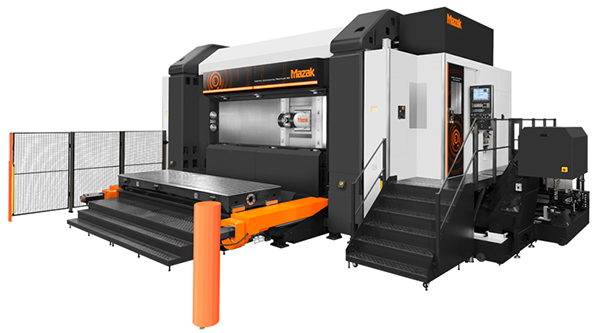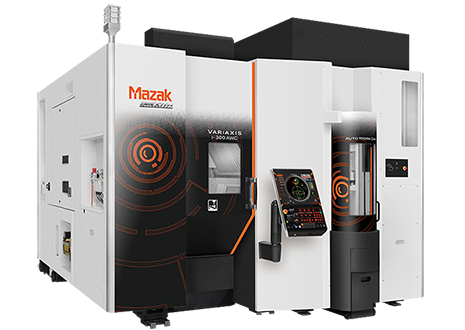Modern machine tools can have multiple axes, but normally only five are used to cut the workpiece at any one time.

What is 5-axis machining?
What is known as full or simultaneous 5-axis machining involves a combination of three linear axes and two rotary axes, moving simultaneously to interpolate complex machined surfaces.
Not all 5-axis work requires simultaneous interpolation and some machines, such as Mazak’s VARIAXIS j-series, offer a version known as ‘4+1’ or ‘3+2’, which enable multi-axis capability, but is not fully simultaneous.

This is where the two rotary axes combine to tilt the workpiece in various positions to execute 3-axis milling strategies. The process, also known as 5-axis positional machining, relies on the fourth and fifth axes to orient the cutting tool in a fixed position, rather than manipulate it continuously during the machining process.
What industry sectors are most suited to 5-axis machining?
5-axis enables the machining of very complex parts, which is why it is especially popular in aerospace; automotive, particularly autosport; die and mold; and medical applications.
Typical parts could be everything from prosthetic replacement joints for the medical sector, through to aircraft structural parts, for which large machines like Mazak’s Vortex Horizontal Profiler 160 – ideal for high-speed aluminium cutting – were specifically designed.

What are the main advantages of 5-axis machining?
Full or simultaneous 5-axis machining has a number of advantages for machine users. Firstly, 5-axis makes it possible to machine highly complex shapes in a single set-up – which ultimately increases productivity by reducing processing and cycle time – and a single CNC programme. This is what we term DONE-IN-ONE machining.
Secondly, 5-axis work means less time and money spent on fixture preparation and, therefore, more machining time. This ultimately gives 5-axis users a faster return on investment and greater profitability.
Finally, 5-axis machining means greater part accuracy as the workpiece does not move across multiple workstations to complete the part, given each re-fixturing has the potential to reduce component accuracy. For example, a valve block can be machined on five sides, reducing the overall throughput time and improving component accuracy.
How difficult is the transition from 3-axis to 5-axis machining?
The move to full 5-axis machining from simpler turning and milling operations can be daunting. But, for those wanting to move away from traditional processes, take their operations onto the next level and potentially open up new markets, such as aerospace work, the benefits can be enormous.
Machine design is particularly important and machine users should look for specific capabilities during the specification process. For example, deflection of the workpiece under cutting load can be an issue with 5-axis work, which led Mazak to offer a fully-supported trunnion with both the VARIAXIS i-series and j-series. Similarly, many Mazak machines are equipped with a number of intelligent functions, such as Intelligent Thermal Shield, which ensures accuracy against thermal drift during the 5-axis machining process.

The big change that machine users new to 5-axis work will discover is the increase in program complexity. As the cutting tool is moving in multiple different directions simultaneously, there is a corresponding leap in tool path strategies. As a result, integrating 5-axis is more complex than simply swapping out a 3-axis lathe, but with the right support the productivity gains will more than merit the journey.
How difficult is 5-axis machine programming?
5-axis programming is a skillset leap for most machine shops, because it requires switching from interpreting traditional 2D drawings to digitising solid models in CAD/CAM, harnessing different cutting tool designs and cutting strategies such as trochoidal tool paths.
The capability of the CNC is a vital component in successfully integrating 5-axis into machining operations. For example, SmoothX – Mazak’s specialist 5-axis CNC – does a lot of the hard work for the programmer, due to its incorporation of a number of advanced programming functions.

SmoothX includes functions such as ‘3D Assist’ for 3+2 type machining. It enables 3D CAD models to be directly imported into the CNC and digitised into a MAZATROL program, reducing programming times and eliminating errors from manual input. Similarly, ‘Quick EIA’ interface includes a high-speed display of tool paths imported from CAD/CAM and the VIEW SURF analysis function can determine tool path errors in the program that could cause surface defects.
SmoothX also includes MAZACHECK, a calibration and machine health check function that, in conjunction with a touch sensor, helps maintain the accuracy of a 5-axis machine, by measuring and automatically compensating for any geometric deviation in the machine’s rotary centre.
How easy is it to automate with 5-axis?
While automation is not a must-have for 5-axis work, it can be a very efficient solution – particularly for those machine-users who manufacture a high mix of components in low volumes and wish to avoid unnecessary downtime from repeated setups. For example, the Mazak VARIAXIS i-300 AWC is a compact simultaneous 5-axis machining centre, equipped with an Auto Work Changer: an expandable large capacity tool magazine, all of which can be controlled and programmed via the SmoothX CNC.

Overall, the incorporation of 5-axis into a machine shop’s strategies will require some handholding and application team technical support. John Hart have developed a reputation for helping customers through what can, at first, seem like a daunting process. However, for those ambitious machine-users wanting to upgrade their capabilities and enter new markets, making the change to 5-axs will undoubtedly represent a step-change in production capacity.
